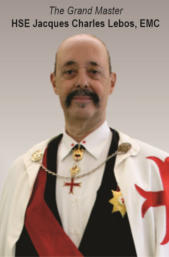
These were the darkest days in the history of the Templars.
In 1314 the Grand Master of the Order, Jacques de Molay, having retracted his forced confession, was burnt to death outside the Cathedral of Notre Dame in Paris.
In
England,
King
Edward
II
eventually
followed
the
French
example
and
seized
all
Templar
properties
for
himself
–
although
the
persecution
of
the
Templars
here
was
not
as
severe
or
far-reaching as in France.
Only
in
countries
such
as
Scotland,
Switzerland
and
Portugal
did
the
Templars
survive
more
or
less
intact
–
and
even
there
they
were
eventually
forced
to
stop
using
the
Order’s
name.
Gradually,
over
the
centuries,
the
Templars
disappeared
from
view.
Their
beliefs
and
traditions,
however,
persisted
–
being
introduced
over
time
to
other
organisations
and
fraternal
societies.
Then,
in
the
late
1700s
the
Order
emerged
from
the
shadows
once
more,
and
such
was
the
revival
of
interest
in
chivalric
values
and
ideals
that
in
1804,
with
the
approval
of
the
Emperor
Napoleon
himself,
a
reconstituted
Order
of
the
Temple
of
Jerusalem
was
officially
inaugurated
in
Paris
–
the
very
place
where
its
downfall
had
been
engineered
by
a
greedy
and
envious
king,
and
where
Jacques de Molay had been martyred.
The Modern Era
(abridged from the archives of Maj Gen Sir Roy Redgrave, 2003)
The new Templar Order was founded in 1705 by the Duke of Orleans and was held in succession until the early 1800s where it had become an anachronism. It was rebuilt in 1804 and protected by Napoleon Bonaparte. The Grand Master at that time was Bernard-Raymond Fabré-Palaprat, but in France, many did not recognize him. Palaprat died in 1838. In 1840, Sir William Sidney Smith, the English Grand Prior, became Grand Master until his death in 1858. The order was annulled in France in 1892 by the Regent, Joséphin Péladan after serious scandals and all publications and archives of the Knights Templar were placed in the National Archives of France, where they are still to this day. In 1894, a kind of “Templar Secretariat” was founded in Belgium and in 1932, the French moved and founded another Templar organization in Belgium, whose president was Theodore Kovias. In 1935, Emile Clement Joseph Isaac Vandenberg was appointed Regent. It is believed that, to prevent the Nazi intentions of taking the archives, that control of the archives was transferred to the Order of a neutral country. On December 23, 1942, two-and-a-half years later, the archives were transferred by Vandenberg to the Consul of Portugal that was Antonio Campello de Souza Fontes. Antonio de Sousa Fontes records that he was unsure of its own legitimacy, but happy to accept the title of Regent. At the time of his death in 1960, Antonio Campello de Souza Fontes appointed his son, Fernando Campello de Souza Fontes as his successor, but this caused a great rift in the Order as there should have been an election for Grand Master. Several international Convents General (meetings) were convened to discuss this, which resulted in many senior officers resigning and taking their members with them to form breakaway and therefore illegitimate Templar Orders. This became known as the Great Schism. A nucleus, however, decided to remain with Fontes and affect change from within, and he remained Grand Master and Regent until he died in 2018. Under its present Grand Master, His Excellency Chevalier Jacques Dubos, of Switzerland, the Order has Grand Priories and Priories throughout the world with thousands of Members. Full Membership of the Knights Templar of England or Wales is open to Christian men or women, over the age of 18, who can show a firm commitment to Christian Unity and values and who is willing to commit him- or herself to serve the Order to the best of their ability.
© The Grand Priory in England of the Knights Templar, 2023





















